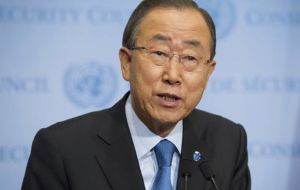MercoPress. South Atlantic News Agency
Historic agreement to phase down HFC gases in air conditioners and refrigerators
 Ban Ki-moon said the Kigali Amendment to the Montreal Protocol builds on the strong global momentum for multilateral efforts to address climate change
Ban Ki-moon said the Kigali Amendment to the Montreal Protocol builds on the strong global momentum for multilateral efforts to address climate change Negotiators from nearly 200 nations reached a historic deal to phase down emissions of hydrofluorocarbons (HFCs) — potent greenhouse gases used in air conditioners and refrigerators. The agreement, a major expansion of the 1987 Montreal Protocol, which eliminated the use of the ozone-depleting chlorofluorocarbons, was finalized during a United Nations meeting in Kigali, Rwanda.
The agreement, which established timetables for the signatories to freeze and then reduce HFC emissions, was announced Saturday after nightlong negotiations.
Under the Kigali amendment, HFCs will now come under the ambit of the Montreal Protocol. Developed nations will begin reducing the use of HFCs incrementally, initially cutting it down by 10% by 2019, and by 85% by 2036 over a 2011-2013 baseline. Over 100 developing countries, including China, will freeze their HFC use by 2024, while a few other developing nations, including India, will do so by 2028.
“This is a huge win for the climate. We have taken the first concrete step in delivering on the promises we made in Paris last December,” the European Union Commissioner for Climate Action and Energy Miguel Arias Cañete said in a statement. “The global phase-down we have agreed today could knock off up to half a degree of warming by the end of the century.”
If this happens, it would mark the largest temperature reduction ever achieved through a single agreement.
HFCs are currently one of the world’s fastest growing greenhouse gases, and, though their atmospheric concentration is far less than carbon dioxide’s, they pack a much greater warming punch. These gases were introduced as a replacement to the far more dangerous chlorofluorocarbons, which, in addition to being potent greenhouse gases, also damage Earth’s protective ozone layer.
Although HFCs cause a greenhouse effect that’s thousands of times more powerful than carbon dioxide’s, their average atmospheric lifetime is roughly 15 years, unlike carbon dioxide, which can persist in the atmosphere for centuries. As a result, eliminating the use of HFCs under the Kigali amendment can, according to an estimate by the New York-based environmental nonprofit Natural Resources Defense Council (NRDC), prevent emitting the equivalent of more than 80 billion tons of carbon dioxide over the next 35 years.
“This is the biggest step we can take in the year after the Paris agreement, and is equal to stopping the entire world’s fossil-fuel CO2 emissions for more than two years,” David Doniger, NRDC’s climate and clean air program director, said. “Bringing HFCs under the Montreal Protocol also sends a clear signal to the global marketplace to start replacing these dangerous chemicals with a new generation of climate-friendly and energy-efficient alternatives.”
UN Secretary-General Ban Ki-moon said the Kigali Amendment to the Montreal Protocol builds on the strong global momentum for multilateral efforts to address climate change, including the landmark Paris Agreement, which will enter into force 4 November; the adoption last week of a global, market-based mechanism for emission reductions by the international aviation industry; and other multilateral efforts under the United Nations Framework for Climate Change Convention (UNFCCC) process.
Adoption of the amendment on HFCs will provide considerable benefits in the coming decades and help advance the Sustainable Development Goals. Significantly, the global phase-down of HFCs could avoid up to half a degree of global warming by the end of this century, providing a major boost for efforts to limit global temperature rise to well below 2 degrees Celsius as stated in the Paris Agreement and to pursue efforts toward 1.5 degrees.




Top Comments
Disclaimer & comment rules-

Read all comments“Although HFCs cause a greenhouse effect that’s thousands of times more powerful than carbon dioxide’s, their average atmospheric lifetime is roughly 15 years, unlike carbon dioxide, which can persist in the atmosphere for centuries.”
Oct 19th, 2016 - 10:36 am 0The effect of HFC's in the atmosphere has not and cannot be demonstrated. The claim of CO2 residence time is shown by other scientists to to be in the order of 5-15 years. Anthropogenic CO2 is well mixed, it does not sit there as some alien presence.
http://www.dw.com/en/banning-the-super-greenhouse-gas/a-36044849
”This agreement was initially understood to prevent a 0.5 degree Celsius (0.9 degree Fahrenheit) increase in global warming by the end of the century.
Although the ban will help in the fight against climate change, uncertainty around HFCs' impacts has tempered this estimate.
“A very straightforward case would mean 0.25 or 0.3 degree of warming prevented,” said Michiel Schaeffer, science director at Climate Analytics. However, this will not count against the 2 degree limit cited in the Paris Agreement.
From 2010: Bogus HFC Offset credits
http://www.dw.com/en/banning-the-super-greenhouse-gas/a-36044849
The majority of Clean Development Mechanism (CDM) offset credits issued to date are bogus, according to new research on industrial gas destruction projects.
Since its inception, the CDM has enabled power companies in industrialised countries (mainly in the European Union) to avoid reducing their emissions through the purchase of “offsets” mostly generated by producers of potent industrial gases in the global South (mostly based in China, India and South Korea).
A UN panel has now found that the largest share of these credits, which originate from projects claiming to destroy the refrigerant gas HFC-23, are bogus.
http://www.dw.com/en/banning-the-super-greenhouse-gas/a-36044849
A consortium of North American and European activists have demanded sweeping changes to the Clean Deve
Commenting for this story is now closed.
If you have a Facebook account, become a fan and comment on our Facebook Page!